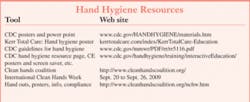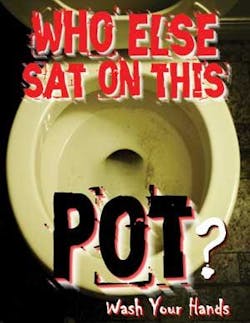That’s gross
by Noel Kelsch, RDHAP
[email protected]
Denver is filled with students. One of them is my precious daughter, Moe. I helped her move to Denver so she could finish her master’s in social work and analyze me better. When we visited the campus I used the restroom there. I watched two young women walk in with cell phones in their hands. They went into their respective stalls and continued their phone conversations. I couldn’t resist shouting, “Welcome to the university restroom. Your friend is sharing your conversation with me as she uses the restroom.” The sudden silence was deafening, but what happened next really shocked me. As the young women walked out murmuring, “Can you believe her?” they didn’t wash their hands!
That was a few years ago, and DU has since done a spectacular job of addressing hand washing, taking a whole new perspective. Associate professor Renee Botta said it takes “gross” messaging to get undergraduate students to wash their hands.
In the fall of 2007, researchers posted messages in the bathrooms of two DU residence halls which said, “You just peed, wash your hands,” and “Poo on you, wash your hands.” These graphic images got attention. The campaign resulted in increased hand washing among females by 26% and among males by 8%.
The study didn’t end there. It included observations in two dorms over four weeks that showed hand washing decreased 2 percentage points among females and 21.5 percentage points among males. Three messages were tried in the dorms — gross messages, germ messages, and you’ll-get-sick messages. According to Katie Dunker, one of the team members that conducted the pilot study, the only one that stuck was gross.
“Fear of spreading germs or getting sick by not washing their hands didn’t mean much to students,” says Botta, the lead author of the study. “What got their attention was knowing they might be walking around with ‘gross things’ on their hands if they didn’t wash.”
Proper hand hygiene is the most critical element of an adequate infection control program in the oral health care setting. However, adherence to proper hand hygiene protocols is often lacking. Poor compliance has been attributed to lack of time, hand irritation or dryness, forgetfulness, skepticism, understaffing, perceived low risk of cross-infection, inconvenience, and the belief that gloves alone offer protection1.
The CDC asks facilities to measure adherence to these hand hygiene recommendations. These include providing feedback to CDC personnel regarding performance, monitoring product usage, and assessing health-care personnel hand hygiene when outbreaks of infection occur.2
“Gross” messaging is one way to stress the importance of hand hygiene. Adhering to hand hygiene guidelines is the simplest and most effective way to stop the spread of disease.2 Clean hands save lives.3
Moe will be graduating soon. She’s available to any mothers or fathers who would like their parenting skills analyzed.
References
- Huber MA, Holton RH, Terezhalmy GT. Cost Analysis of Hand Hygiene Using Antimicrobial Soap and Water Versus an Alcohol-Based Hand Rub. J Contemp Dent Pract 2006 May;(7)2:037-045.
- Centers for Disease Control and Prevention. Guideline for Hand Hygiene in Health-Care Settings: Recommendations of the Healthcare Infection Control Practices Advisory Committee and the HICPAC/SHEA/APIC/IDSA Hand Hygiene Task Force. MMWR 2002;51
- http://www.cleanhandscoalition.org/
About the Author
Noel Brandon Kelsch, RDH, is a freelance cartoonist, writer, and speaker. She has received many national awards including Colgate Bright Smiles Bright Futures and Sunstar/RDH Award of Distinction. Her family lives in Moorpark, Calif.



